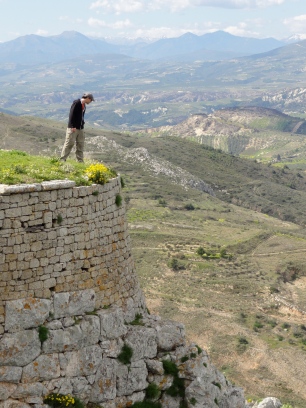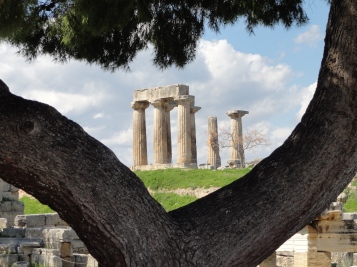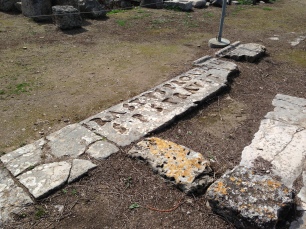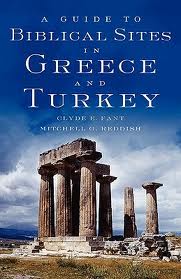Last month I was able to travel to Greece and Turkey with my brother. I wanted to share my experience in each city, as well as some insights gained. For a preview of the trip, read the A Guide to Biblical Sites in Greece and Turkey entry and read my thoughts on Athens.
—————————–
 The Biblical city of Corinth is about an hour train ride from Athens, though for the Apostle Paul it may have been 2 or 3 days journey. From the train station, we took a taxi to the Acrocorinth. The Acrocorinth is an 1,800 ft. high natural rock fortress that serves as the backdrop to many photos of the ancient city. It strategically oversees the narrow strip of land that separates the Peloponnesian Peninsula from mainland Greece, and thus gave Corinth an elevated military and economic status. Oddly, most tourists skip the Acrocorinth and head straight for the ancient city. This is a mistake! I had read that we were likely to have the walled fortress to ourselves and that was indeed the case. We spent a good hour (and could have spent more) exploring the citadel’s three gates that offered the only access to the top, the mostly intact walls encircling the summit, and various structures representing different eras of occupation over the past 2,500 years.
The Biblical city of Corinth is about an hour train ride from Athens, though for the Apostle Paul it may have been 2 or 3 days journey. From the train station, we took a taxi to the Acrocorinth. The Acrocorinth is an 1,800 ft. high natural rock fortress that serves as the backdrop to many photos of the ancient city. It strategically oversees the narrow strip of land that separates the Peloponnesian Peninsula from mainland Greece, and thus gave Corinth an elevated military and economic status. Oddly, most tourists skip the Acrocorinth and head straight for the ancient city. This is a mistake! I had read that we were likely to have the walled fortress to ourselves and that was indeed the case. We spent a good hour (and could have spent more) exploring the citadel’s three gates that offered the only access to the top, the mostly intact walls encircling the summit, and various structures representing different eras of occupation over the past 2,500 years.
In the middle of an overgrown patch of ground at the top, one can see the foundation of a temple to Aphrodite. Strabo wrote that this temple was once home to a thousand temple prostitutes. More on this below, but it is difficult to capture the full impact of Corinth if you skip the Acrocorinth.
 After overcoming a small language barrier (tip: when the taxi driver quotes you 15 Euro to shuttle you around Corinth, it is best to confirm in writing that he is not actually quoting you 50 Euro) we were dropped at the site of the city of Paul’s day. The first thing you notice is the remaining columns from the Temple of Apollo, dating back to the 6th-century BC. We began with the museum, which houses numerous artifacts discovered at the site and gave a flavor for what the city must have been like when Paul arrived from Athens. Two main streets, the city agora, and other temple sites allowed us to wander and explore far more than can initially be observed from the entrance. An adjacent site across the parking lot offers a glimpse of the ancient theater and the Odeon.
After overcoming a small language barrier (tip: when the taxi driver quotes you 15 Euro to shuttle you around Corinth, it is best to confirm in writing that he is not actually quoting you 50 Euro) we were dropped at the site of the city of Paul’s day. The first thing you notice is the remaining columns from the Temple of Apollo, dating back to the 6th-century BC. We began with the museum, which houses numerous artifacts discovered at the site and gave a flavor for what the city must have been like when Paul arrived from Athens. Two main streets, the city agora, and other temple sites allowed us to wander and explore far more than can initially be observed from the entrance. An adjacent site across the parking lot offers a glimpse of the ancient theater and the Odeon.
 The final stop in Corinth was the Corinth Canal. The canal cuts through rock across the 4-mile strip of land that connects the Gulf of Corinth to the Aegean Sea. It was completed in 1893 but soon became unworkable for modern ships. Yet it still represents an impressive feat of engineering. It is also the location for several ancient attempts to bridge the two bodies of water at the Corinth harbor. Julius Caesar began plans to dig a canal here before his assassination. Caligula revived the plan, but it was not until Nero that the project got underway. The huge effort stalled and eventually became a road that transported smaller vessels across the strip of land.
The final stop in Corinth was the Corinth Canal. The canal cuts through rock across the 4-mile strip of land that connects the Gulf of Corinth to the Aegean Sea. It was completed in 1893 but soon became unworkable for modern ships. Yet it still represents an impressive feat of engineering. It is also the location for several ancient attempts to bridge the two bodies of water at the Corinth harbor. Julius Caesar began plans to dig a canal here before his assassination. Caligula revived the plan, but it was not until Nero that the project got underway. The huge effort stalled and eventually became a road that transported smaller vessels across the strip of land.
The archaeological site corresponds well to Paul’s two letters to the Corinthian church. Here are just a few of the points of contact:
Insight #1 – The Temple of Aphrodite. As noted above, the Acrocorinth was home to the Temple of Aphrodite. Corinth was also a harbor town with a constant influx of sailors. It is debated whether worshippers would have made the trek up to this temple or if it simply served as a backdrop to the sacred prostitution in the city itself. Regardless, there is little doubt that the Temple of Aphrodite atop the Acrocorinth would have literally cast a shadow on the town below. Corinth became synonymous with sketchy behavior. Undoubtedly, this explains why Paul spends a considerable amount of space warning the Corinthians about sexual immorality:
Do you not know that your bodies are members of Christ himself? Shall I then take the members of Christ and unite them with a prostitute? Never!
The practice was not simply one that offered temptation if you wandered into the wrong section of town, but it hung over the city like a cloud. All you had to do was look up anywhere in the city and you were reminded of the city’s notoriety.
Insight #2 – Temple of Asclepius. There is a room in the museum at Corinth where you will find replicas of an assortment of body parts. These have been found at the site of a nearby temple to Asclepius. Asclepius was a deified Greek physician, whose symbol of entwined snakes still represents the medical community today. The site included dorms and baths where the sick would come to heal and recover. People would also offer these replicated body parts analogous to their illness as votive offerings for healing. One cannot help but see these and reflect back on Paul’s imagery of the body when writing to the church at Corinth.
Just as a body, though one, has many parts, but all its many parts form one body, so it is with Christ.
It is possible that Paul may have seen these votive offerings being sold in the local market to the sick headed up to the Asclepion. While all these body parts look a little creepy, when fully assembled and animated with life, the body become a marvel. Is this what Paul envisioned when he was speaking of the church? Elsewhere Paul encourages believers to offer their whole body – all its parts – as a living sacrifice, perhaps as opposed to votive offerings to Asclepius.
 Insight #3 – The Erastus Inscription. As you make your way across the parking lot of the site down to the theater grounds, you will notice a sectioned-off area on the stone pavement below. A large inscription on the stone reads, “Erastus, in return for his aedileship, paved this at his own expense.” This is known as the Erastus Inscription and is an important find, as it may refer to the same Erastus mentioned in Romans 16:23, “Erastus, who is the city’s director of public works, and our brother Quartus send you their greetings.” It is one of only a couple inscriptions that can be linked to a reference from Paul and the New Testament.
Insight #3 – The Erastus Inscription. As you make your way across the parking lot of the site down to the theater grounds, you will notice a sectioned-off area on the stone pavement below. A large inscription on the stone reads, “Erastus, in return for his aedileship, paved this at his own expense.” This is known as the Erastus Inscription and is an important find, as it may refer to the same Erastus mentioned in Romans 16:23, “Erastus, who is the city’s director of public works, and our brother Quartus send you their greetings.” It is one of only a couple inscriptions that can be linked to a reference from Paul and the New Testament.
Insight #4 – The Isthmian Games. Corinth was a sports town, as we might say today. Corinth hosted the Isthmian Games, second only to the ancient Olympic Games, for several centuries. By the time Paul arrived in Corinth, the games already had a 500-year history. There are several tantalizing metaphors along these lines that Paul utilizes in his letters to the Corinthians. We stood on a long road next to the ancient agora that served as a race course lined with box seating for dignitaries. If Paul sold his leather-goods and tents in the agora he would have been familiar with this path. His time in Corinth may have overlapped during one of these games, as they were held every two years. The winner of an event would have received a garland of a type of celery, which quickly wilts after being plucked from the ground.
Everyone who competes in the games goes into strict training. They do it to get a crown that will not last; but we do it to get a crown that will last forever.
These are only a couple of references Paul mentions throughout his letters to running a race and winning a crown or claiming the prize. Quite fitting for a sports town!
The next stop is Ephesus!
